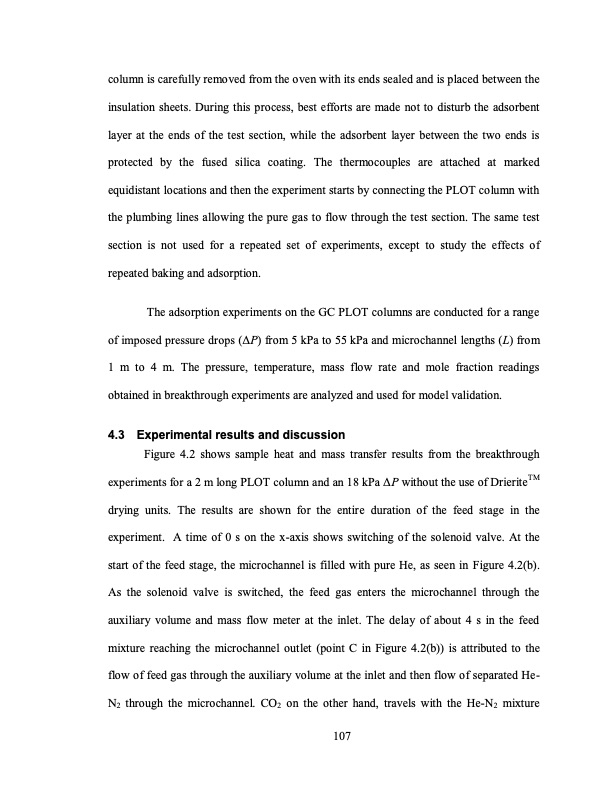
PDF Publication Title:
Text from PDF Page: 134
column is carefully removed from the oven with its ends sealed and is placed between the insulation sheets. During this process, best efforts are made not to disturb the adsorbent layer at the ends of the test section, while the adsorbent layer between the two ends is protected by the fused silica coating. The thermocouples are attached at marked equidistant locations and then the experiment starts by connecting the PLOT column with the plumbing lines allowing the pure gas to flow through the test section. The same test section is not used for a repeated set of experiments, except to study the effects of repeated baking and adsorption. The adsorption experiments on the GC PLOT columns are conducted for a range of imposed pressure drops (ΔP) from 5 kPa to 55 kPa and microchannel lengths (L) from 1 m to 4 m. The pressure, temperature, mass flow rate and mole fraction readings obtained in breakthrough experiments are analyzed and used for model validation. 4.3 Experimental results and discussion Figure 4.2 shows sample heat and mass transfer results from the breakthrough experiments for a 2 m long PLOT column and an 18 kPa ΔP without the use of DrieriteTM drying units. The results are shown for the entire duration of the feed stage in the experiment. A time of 0 s on the x-axis shows switching of the solenoid valve. At the start of the feed stage, the microchannel is filled with pure He, as seen in Figure 4.2(b). As the solenoid valve is switched, the feed gas enters the microchannel through the auxiliary volume and mass flow meter at the inlet. The delay of about 4 s in the feed mixture reaching the microchannel outlet (point C in Figure 4.2(b)) is attributed to the flow of feed gas through the auxiliary volume at the inlet and then flow of separated He- N2 through the microchannel. CO2 on the other hand, travels with the He-N2 mixture 107PDF Image | TEMPERATURE SWING ADSORPTION PROCESSES FOR GAS SEPARATION

PDF Search Title:
TEMPERATURE SWING ADSORPTION PROCESSES FOR GAS SEPARATIONOriginal File Name Searched:
PAHINKAR-DISSERTATION-2016.pdfDIY PDF Search: Google It | Yahoo | Bing
CO2 Organic Rankine Cycle Experimenter Platform The supercritical CO2 phase change system is both a heat pump and organic rankine cycle which can be used for those purposes and as a supercritical extractor for advanced subcritical and supercritical extraction technology. Uses include producing nanoparticles, precious metal CO2 extraction, lithium battery recycling, and other applications... More Info
Heat Pumps CO2 ORC Heat Pump System Platform More Info
| CONTACT TEL: 608-238-6001 Email: greg@infinityturbine.com | RSS | AMP |